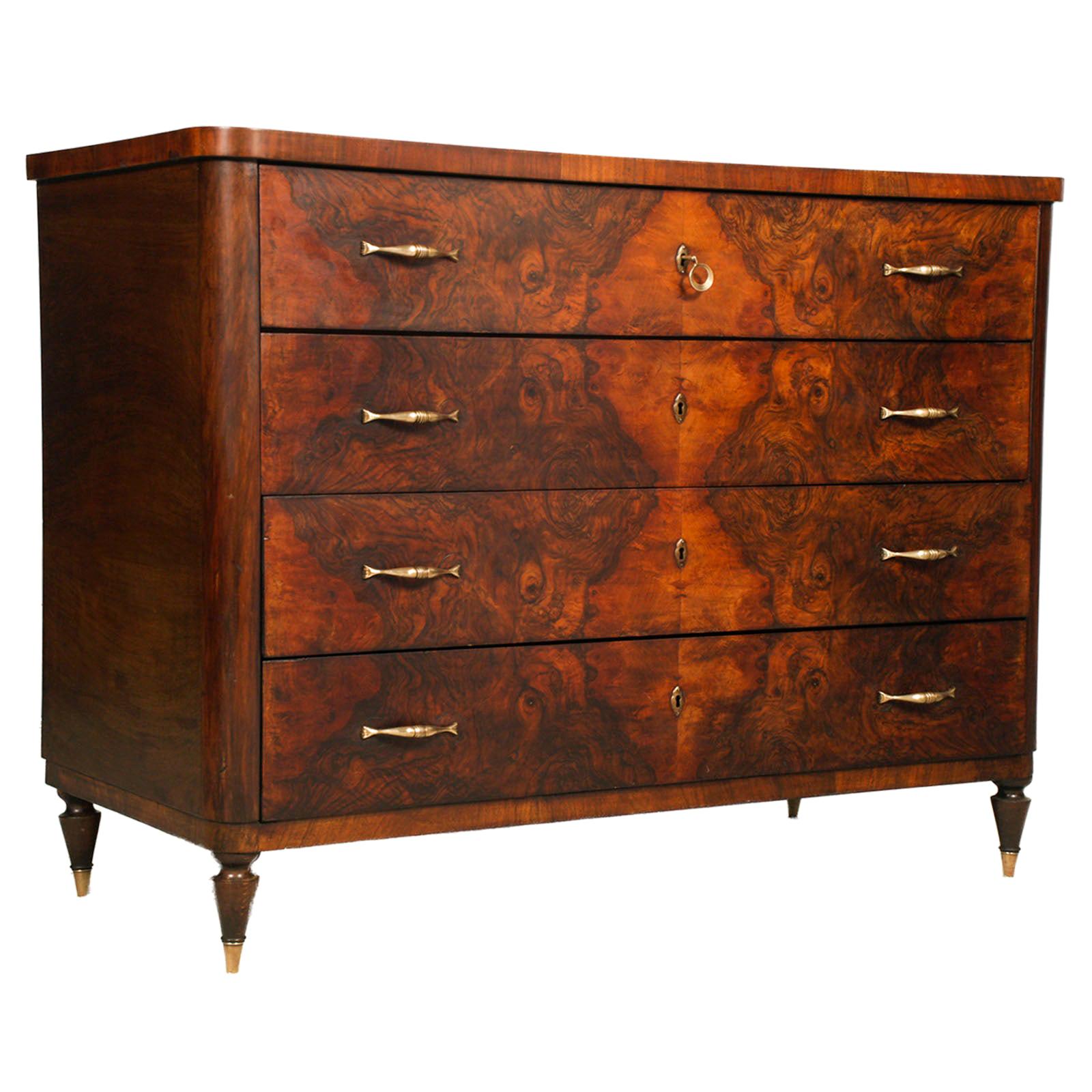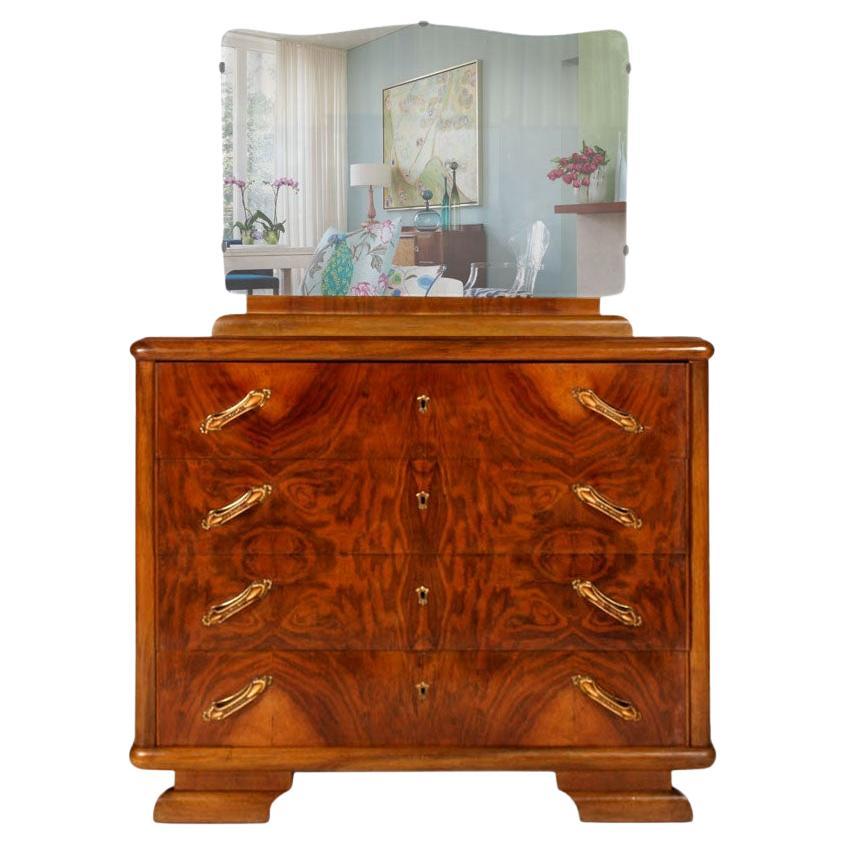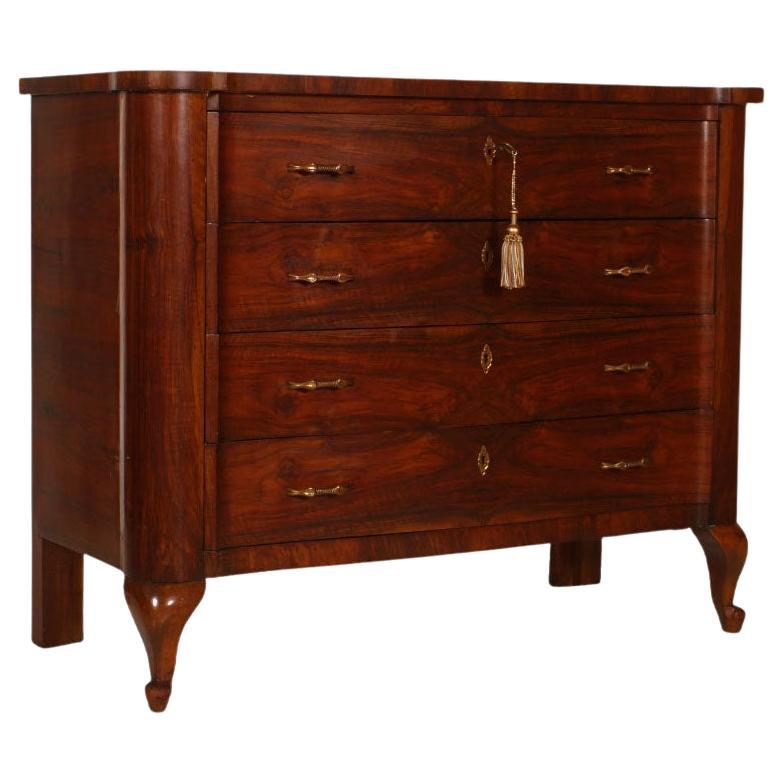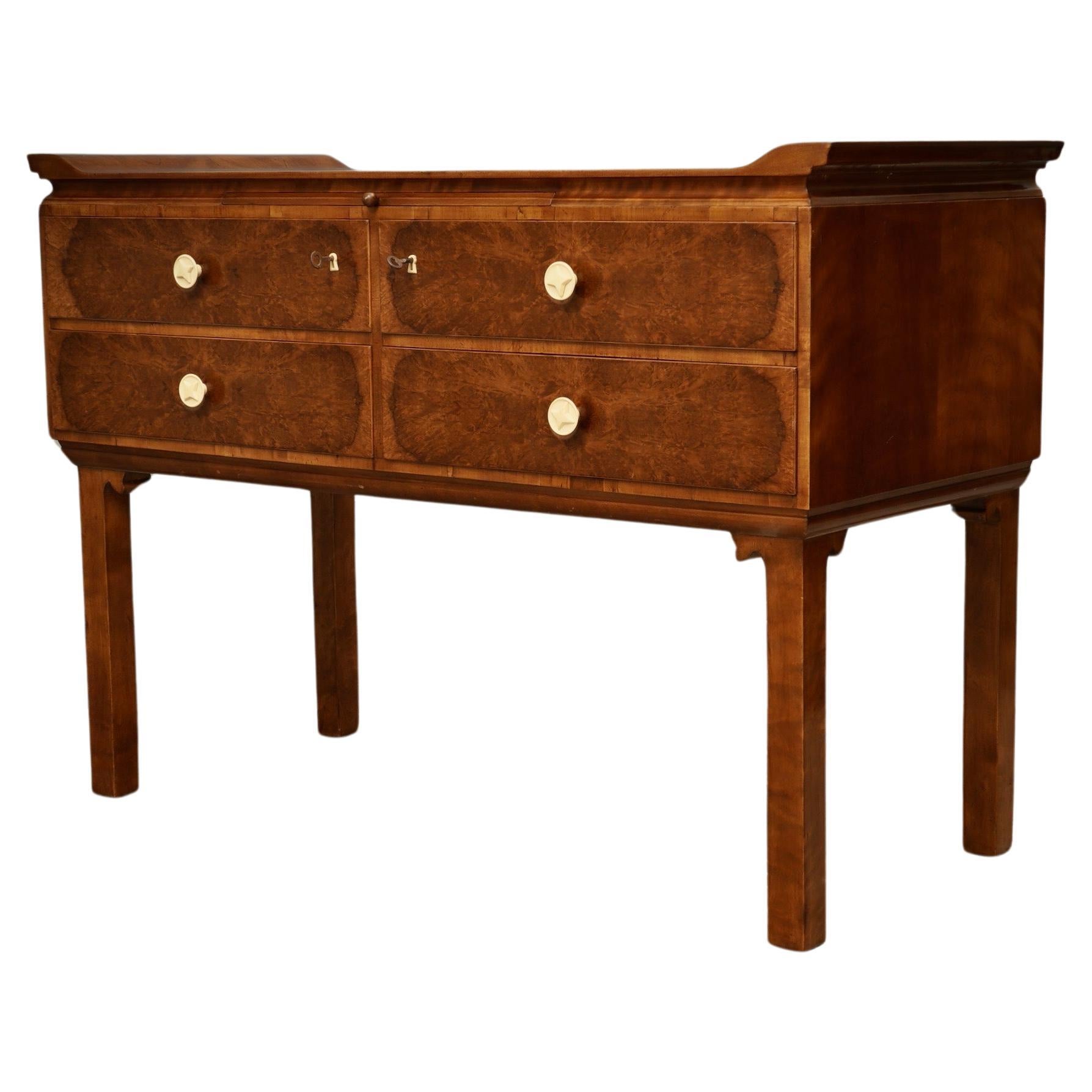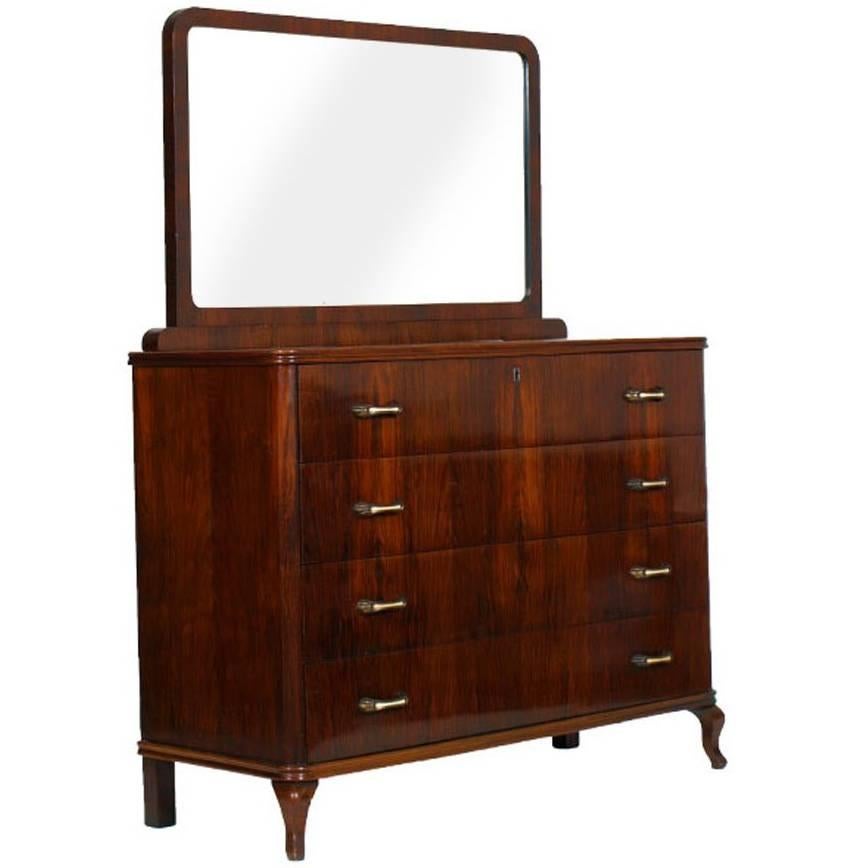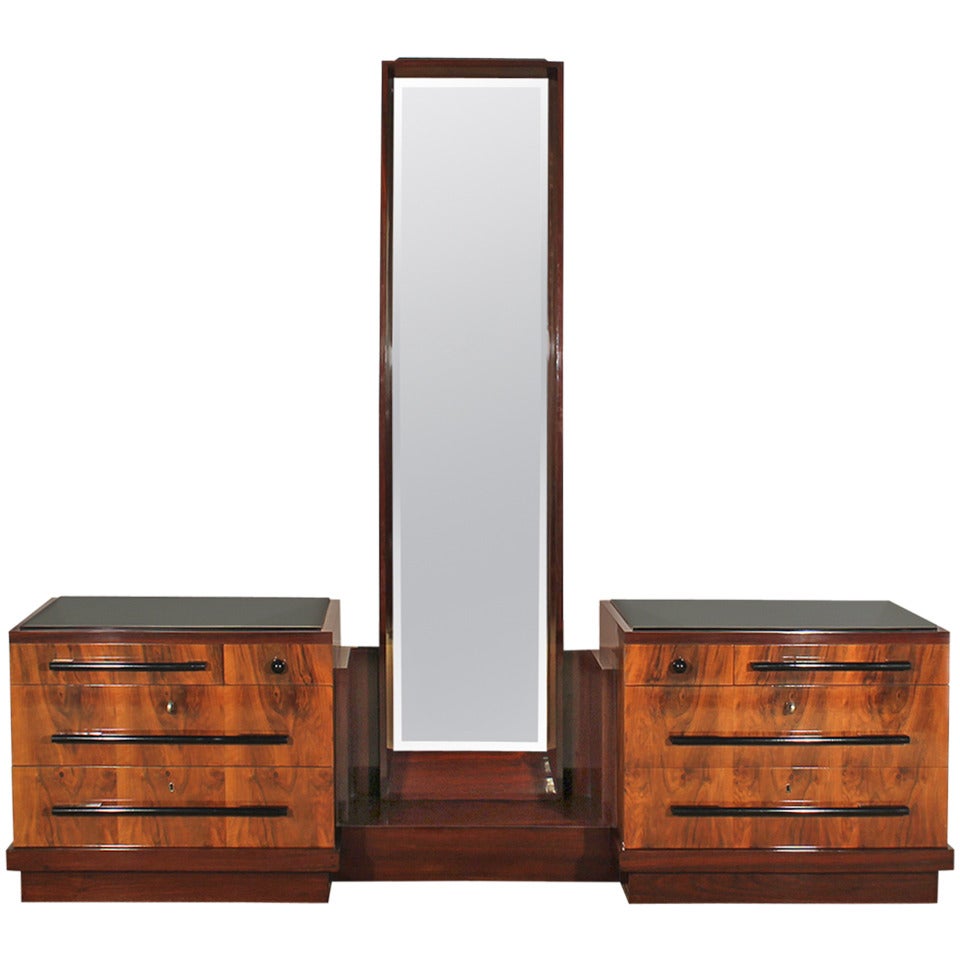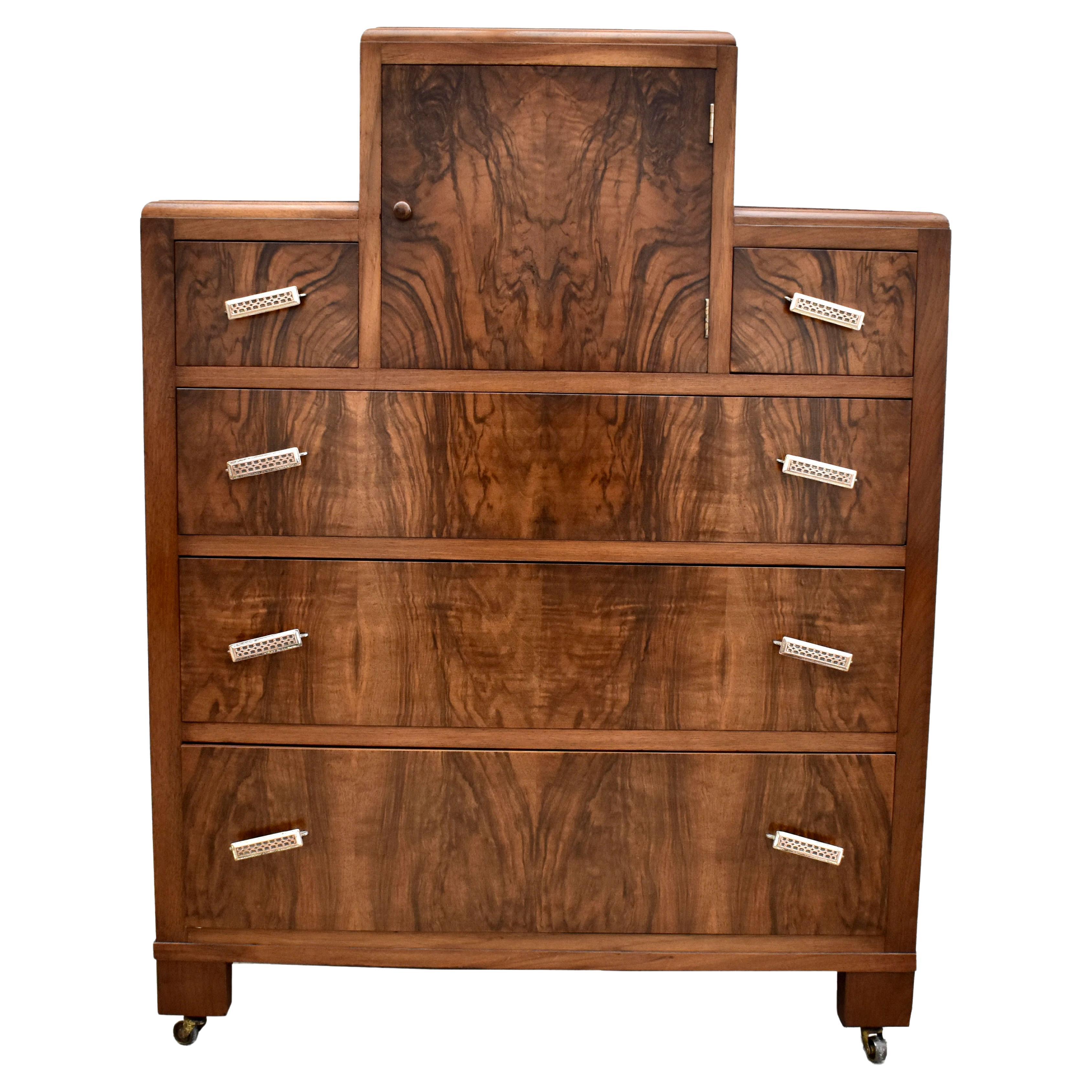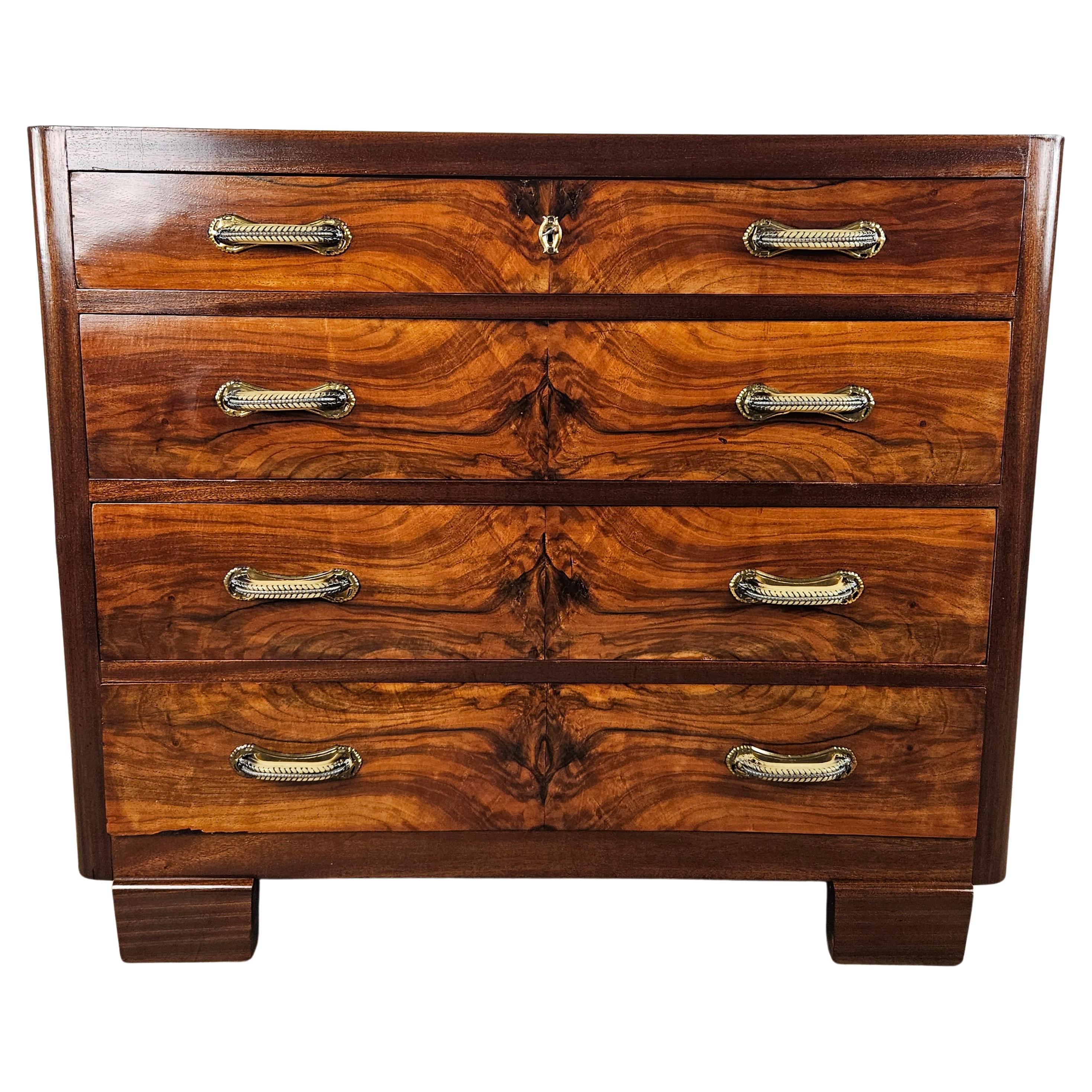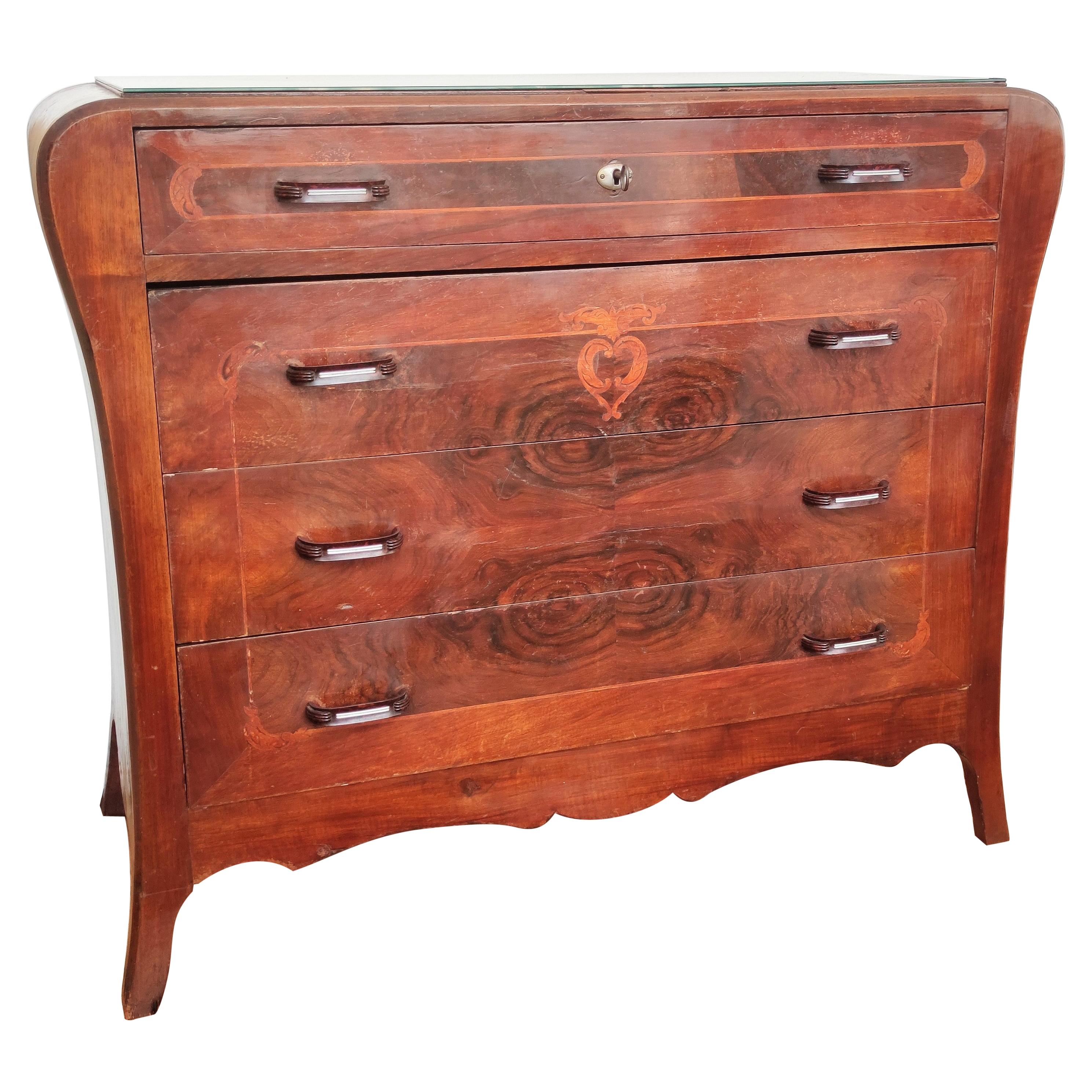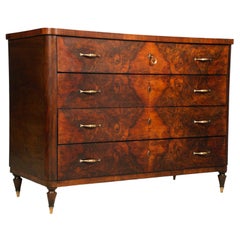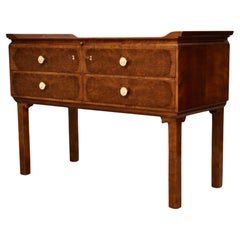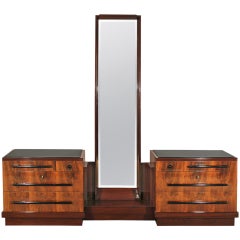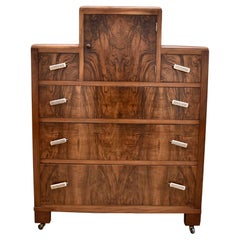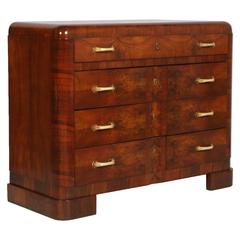
Gaetano Borsani 1930s Art Deco Chest of Drawers Dresser Commode in Burl Walnut
View Similar Items
Want more images or videos?
Request additional images or videos from the seller
1 of 5
Gaetano Borsani 1930s Art Deco Chest of Drawers Dresser Commode in Burl Walnut
About the Item
- Creator:Gaetano Borsani (Cabinetmaker)
- Dimensions:Height: 37.8 in (96 cm)Width: 48.04 in (122 cm)Depth: 20.48 in (52 cm)
- Style:Art Deco (Of the Period)
- Materials and Techniques:
- Place of Origin:
- Period:
- Date of Manufacture:1930s
- Condition:Minor losses. In good condition, polished shellac.
- Seller Location:Vigonza, IT
- Reference Number:Seller: FI811stDibs: LU249536693553
About the Seller
4.9
Vetted Seller
These experienced sellers undergo a comprehensive evaluation by our team of in-house experts.
Established in 2017
1stDibs seller since 2017
283 sales on 1stDibs
Typical response time: 3 hours
More From This SellerView All
- 1920s Art Deco Commode by Gaetano Borsani, Burl Walnut, wox-polishedBy Gaetano BorsaniLocated in Vigonza, PaduaItalian, 1920s Art Deco commode by Gaetano Borsani, in walnut and burl walnut, with golden brass handle and foot. Polished to wax. Gaetano Borsani, with his Atelier di Varedo was a n...Category
Vintage 1920s Italian Art Deco Commodes and Chests of Drawers
MaterialsWalnut, Burl
- 1930s Art Deco Commode in Burl Walnut by Osvaldo Borsani Per Atelier Di VaredoBy Osvaldo Borsani, Gaetano BorsaniLocated in Vigonza, PaduaMajestic and elegant chest of drawers by Osvaldo Borsani produced in the Varedo Atelier of his father Gaetano Borsani , original in every part, with bakelite handles, 1930s Art Deco chest of drawers, commode , in burl walnut with mirror, polished to wax. Excellent condition. Measures cm: D 53, W 120, H 100. mirror cm: W 90 H 75. About Osvaldo Borsani Osvaldo Borsani (born 1911, Varedo, Italy–died 1985, Milano, Italy) was an Italian designer and architect, born into a family of furniture makers with along and well established artisanal tradition. His father, Gaetano Borsani, owned his own furniture shop, the Atelier di Varedo, where the 16-year-old Osvaldo received his first training. At that time, the designer of the atelier was the architect Gino Maggioni, who brought with him influences of the early 20th century Jugendstil movement from Vienna and who instilled in the young Borsani an appreciation for the arts and crafts and furniture making. Osvaldo Borsani first studied fine arts at Accademia di Belle Arti di Brera in Milan, graduating in 1931, and then pursued studies in architecture at Politecnico di Milano, where he graduated in 1936. In 1933, two years before graduating as an architect, Borsani designed the Casa Minima project for the V Triennale di Milano (Milan Triennial), along with architects Cairoli and Varisco. This project earned him a silver medal for its Rationalist code and geometries, and he received positive reviews from the critic Edoardo Persico of Casabella magazine. Villa Borsani And Other Prominent Architectural Work In 1937, Osvaldo Borsani designed Villa Presenti in Forte dei Marmi, a sea town in Tuscany where the Italian aristocracy and industrial elite would build their houses, a project that displayed the same rationalistic rigor displayed in Casa Minima, but softened by the use of mediterranean finishes and materials. Villa Borsani designed by Osvaldo Borsani. Varedo, Italy Villa Borsani. Varedo, Italy In 1943, Osvaldo designed and built his own house, the Villa Borsani, in Varedo, which, despite being conceptualized under strict Rationalist principles, incorporated objects and art of younger artists that communicate a freer approach to the human expression. The Villa Borsani project involved artists such as Adriano Spilimbergo, Fausto Melotti, Lucio Fontana (who made the ceramic fireplace and the ceramic Madonna), and Agenore Fabbri (who made the bronze statue in the staircase). To this day, Villa Borsani has been preserved with most of its original furniture and it remains with Osvaldo Borsani’s family along with the extensive archives of his work. Osvaldo Borsani As a Successful Product and Furniture Designer After Villa Borsani, Osvaldo continued to develop many projects for the Milanese bourgeoisie, frequently with many of the same artists whom he employed for his villa. A particularly strong relationship was the one that Osvaldo developed with artist Lucio Fontana, a close friend since the time of the Accademia de Belle Arti di Brera, and whom Borsani assigned to make a large metal balcony for the Tecno company in 1956. Osvaldo Borsani’s design work, just as his larger architectural projects, which he also considered design work, very often incorporated elements created by other artists and designers such as: Roberto Crippa, Arnaldo and Giò Pomodoro, Agenore Fabbri, Fausto Melotti, Andrea Cascella...Category
Vintage 1920s Italian Art Deco Commodes and Chests of Drawers
MaterialsMirror, Walnut, Burl
- 1920s Art Deco Commode & Nightstands, in Burl Walnut , by Gaetano BorsaniLocated in Vigonza, PaduaItalian 1920s elegant Art Deco Commode with pair of nightstands in burl walnut Two nightstands with commode by Gaetano Borsani , in burl walnut , with golden brass handle and foot. ...Category
Vintage 1930s Italian Art Deco Commodes and Chests of Drawers
MaterialsWalnut, Burl
- 1930s Art Deco Wall Mirror by Gaetano Borsani Framed Walnut with Burl WalnutBy Gaetano BorsaniLocated in Vigonza, PaduaItaly midcentury 1930s Art Deco wall mirror by Gaetano Borsani with frame in carved walnut and burl walnut. Wax polished This mirror was part of a drawer marked Gaetano Borsani. ...Category
Mid-20th Century Italian Art Deco Wall Mirrors
MaterialsMirror, Walnut
- Mid-Century Art Decò Venetian Baroque Commode by Gaetano e Osvaldo BorsaniBy Osvaldo Borsani, Gaetano BorsaniLocated in Vigonza, PaduaElegant Venetian chest of drawers from the 1930s produced by Gaetano Borsani and attributed to the young Osvaldo Borsani, with shaped top and rounded shapes with 4 drawers, made of veneered walnut. Golden brass opening handles. Revised and wax polished. His two bedside tables published with code FP12b About Gaetano e Osvaldo Borsani Osvaldo Borsani (born 1911, Varedo, Italy–died 1985, Milano, Italy) was an Italian designer and architect, born into a family of furniture makers with along and well established artisanal tradition. His father, Gaetano Borsani, owned his own furniture shop, the Atelier di Varedo, where the 16-year-old Osvaldo received his first training. At that time, the designer of the atelier was the architect Gino Maggioni, who brought with him influences of the early 20th century Jugendstil movement from Vienna and who instilled in the young Borsani an appreciation for the arts and crafts and furniture making. Osvaldo Borsani first studied fine arts at Accademia di Belle Arti di Brera in Milan, graduating in 1931, and then pursued studies in architecture at Politecnico di Milano, where he graduated in 1936. In 1933, two years before graduating as an architect, Borsani designed the Casa Minima project for the V Triennale di Milano (Milan Triennial), along with architects Cairoli and Varisco. This project earned him a silver medal for its Rationalist code and geometries, and he received positive reviews from the critic Edoardo Persico of Casabella magazine. Villa Borsani And Other Prominent Architectural Work In 1937, Osvaldo Borsani designed Villa Presenti in Forte dei Marmi, a sea town in Tuscany where the Italian aristocracy and industrial elite would build their houses, a project that displayed the same rationalistic rigor displayed in Casa Minima, but softened by the use of mediterranean finishes and materials. Villa Borsani designed by Osvaldo Borsani. Varedo, Italy Villa Borsani. Varedo, Italy In 1943, Osvaldo designed and built his own house, the Villa Borsani, in Varedo, which, despite being conceptualized under strict Rationalist principles, incorporated objects and art of younger artists that communicate a freer approach to the human expression. The Villa Borsani project involved artists such as Adriano Spilimbergo, Fausto Melotti, Lucio Fontana (who made the ceramic fireplace and the ceramic Madonna), and Agenore Fabbri (who made the bronze statue in the staircase). To this day, Villa Borsani has been preserved with most of its original furniture and it remains with Osvaldo Borsani’s family along with the extensive archives of his work. Osvaldo Borsani As a Successful Product and Furniture Designer After Villa Borsani, Osvaldo continued to develop many projects for the Milanese bourgeoisie, frequently with many of the same artists whom he employed for his villa. A particularly strong relationship was the one that Osvaldo developed with artist Lucio Fontana, a close friend since the time of the Accademia de Belle Arti di Brera, and whom Borsani assigned to make a large metal balcony for the Tecno company in 1956. Osvaldo Borsani’s design work, just as his larger architectural projects, which he also considered design work, very often incorporated elements created by other artists and designers such as: Roberto Crippa, Arnaldo and Giò Pomodoro, Agenore Fabbri, Fausto Melotti, Andrea Cascella...Category
Vintage 1930s Italian Baroque Revival Commodes and Chests of Drawers
MaterialsWalnut
- 1930s Art Deco Venetian Mirrored Dresser, Commode in Walnut , Polished to WaxLocated in Vigonza, PaduaVenetian 1930s Art Deco mirrored dresser, commode, in walnut sanitized and polished to wax. Measures cm: H 98 x W 120 x D 50.Category
Vintage 1930s Italian Art Deco Dressers
MaterialsMirror, Walnut
You May Also Like
- Art Deco "Chinoiserie" Walnut Austrian Commode and Chest of Drawers, 1930Located in Rome, ITAustrian Art Deco chest of drawers. Chinoiserie by the very particular design. All veneered in walnut wood, with four drawers. The top of the dresser is flat but has two movements o...Category
Vintage 1930s Austrian Art Deco Commodes and Chests of Drawers
MaterialsPlastic, Walnut
- 1930s Art Deco Double Chest of Drawers, Mirror, Walnut, Mahogany - ItalyLocated in Girona, ESArt Deco double chest of drawers with central original mirror, walnut and mahogany veneered, eight drawers, black opaline on top. Chests height: 68 cm. Italy, 1930.Category
Vintage 1930s Italian Art Deco Commodes and Chests of Drawers
MaterialsWalnut, Mahogany
- Art Deco English Burr Walnut Chest of Five Drawers, circa 1930sLocated in Devon, EnglandVery stylish Art Deco walnut chest of five drawers originating from England and dating to the 1930's. It has stunning walnut veneers with original Art Deco handles in chromed brass. ...Category
Mid-20th Century English Art Deco Commodes and Chests of Drawers
MaterialsBrass
- Art Deco chest of drawers in walnut burl and mahogany 1940sLocated in Premariacco, ITElegant walnut burl and mahogany dresser from the early 1940s, Italian production of high quality and workmanship. Linear design and small size with proportions ideal for any kind o...Category
Vintage 1940s Italian Art Deco Commodes and Chests of Drawers
MaterialsMahogany, Walnut
- English Art Deco Quilted Maple Chest of Drawers, 1930sLocated in Norwich, GBA superb Art Deco quilted maple and walnut chest of four graduating drawers, with step form back and inward swept plinth. Circa 1930. The chest is ven...Category
Vintage 1930s English Art Deco Commodes and Chests of Drawers
MaterialsMaple, Walnut
$2,938 Sale Price20% Off - Art Deco, Intarsia Chest of Drawers in Birch, Swedish Grace, 1930sLocated in Odense, DKThis fine chest of drawers is a stylish furniture piece crafted from birch wood, embodying the sleek lines and a graceful buidling motif characteristic of the Art Deco era. It featur...Category
Early 20th Century Swedish Art Deco Commodes and Chests of Drawers
MaterialsBirch, Pine
Recently Viewed
View AllMore Ways To Browse
Walnut Dresser 1930
Deco Burl Dresser
Art Deco Burl Dresser
1930 Italian Dresser
Walnut Burl Deco Dresser
Borsani Dresser
Art Deco Dresser With Bakelite Handles
Antique White Oak Furniture
19th Century Pair Of Commodes
Circa 1730
Pair Of Walnut Chests
White Drawer Pulls
Pair Of Marble Top Cabinets
19th Century Mahogany Brass Inlaid
Pair Modern Commodes
Antique Ring Pulls
Mahogany Campaign
Modern Pair Of Commodes
